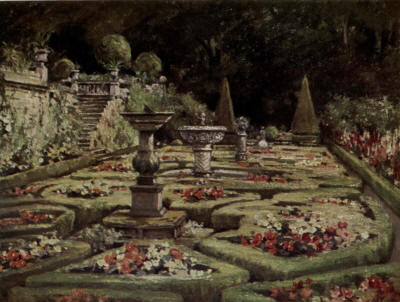|
 is
told of a distinguished Frenchman who applied himself resolutely to
master the anomalies of English orthography and pronunciation, that he
made famous progress with ordinary vocables such as "cough" and
"plough," "read" and "bread," the verb "sow" and the substantive "sow,"
etc. ; but had to confess himself gravelled among proper names. "Here,"
he complained, "is a gentleman who spells his name
C-H-O-L-M-O-N-D-E-L-E-Y, and you tell me it sounds `Marchbanks!' But it
is not reasonable, that!" is
told of a distinguished Frenchman who applied himself resolutely to
master the anomalies of English orthography and pronunciation, that he
made famous progress with ordinary vocables such as "cough" and
"plough," "read" and "bread," the verb "sow" and the substantive "sow,"
etc. ; but had to confess himself gravelled among proper names. "Here,"
he complained, "is a gentleman who spells his name
C-H-O-L-M-O-N-D-E-L-E-Y, and you tell me it sounds `Marchbanks!' But it
is not reasonable, that!"
Equally deceitful is the
pitfall dug for the southerner who mispronounces the name Dalzell
according to its spelling, or, as he or she may feel disposed to put it,
pronounces it according to the misspelling. The correct pronunciation is
attained simply by naming the consonants D L, with stress on the L.
"Then, why on earth," grumbles the English visitor, "cannot Scotsmen
spell names as they wish them pronounced?" To which fair rejoinder might
be made by referring to such English names as Worcester, Cirencester,
etc.; only that is the to quoque

form of argument—scarcely
courteous, I trow; so it may be explained that in the old Scottish
alphabet the character z did not represent the soft sibilant as in
"zebra," but the consonantal y, as in "youth," to distinguish it from
the vowel y, as in "syllable." If you press me further and inquire how "Dal"
can fairly be supposed to represent the sound "dee," I am driven to
retort that it is no whit more absurd than to write "Pontefract" when
you mean one to read "Pomfret." So we start fair, you see: and having
settled that point, let us look into Lord Hamilton's pretty Clydeside
garden.
It is formed in terraces
cut in the steep side of a deep and rocky gorge, through which a burn
brawls impatiently to join the sweeping Clyde. Quoth William Cobbett,
who paid a visit to Dalzell in 1832, "Here, were I compelled to live in
Scotland, would I choose to reside." Since that time seventy—nearly
eighty—years have run, to the mighty detriment of the atmosphere ; for
the development of mining, smelting, and malodorous industries in
variety has greatly altered for the worse the aspect of this part of
Clydesdale. Scarcely would Sir Walter Scott recognise the groves round
neighbouring Cambusnethan, where there is a railway station, solemnly
placarded as "Tillietudlem," in compliance with the unconscious decree
of the Wizard of the North.
But what Dalzell has lost
in environment it has gained in the charm of contrast. You step off the
tram midway between the busy hives of Motherwell and Wishaw, enter the
park gate, and you have not passed far beneath an avenue of limes before
you have exchanged an atmosphere pulsating with industry and pungent
with its waste products into one vibrating with the song of birds and
redolent of hawthorn and lilac. On the way to the flower garden you pass
some fine trees—notably, an immense oak close to the castle. It
separates into several great branches at ten feet above the ground, and
is not remarkable for height; but it contains an enormous bulk of solid
timber, the bole at its narrowest part measuring twenty-four feet in
girth. It is a deceptive tree in one respect. At first sight I judged it
to be of the sessile-flowered variety, which is the prevailing native
form in the western districts of Scotland; and this impression was
confirmed by the fact that the leaves were set on foot-stalks. But
closer inspection showed that the flowers were also on long foot-stalks,
that the leaves had "auricles" or little rounded flaps at the base, and
that they were perfectly smooth on the back, without the pubescence
which the sessile oak invariably has in greater or less quantity. This
tree, therefore, belongs undoubtedly to the pedunculate race.
The flower garden is set
on the terraces on the south side of the house, and very charming it is,
with a happy combination of formality and freedom. Miss Wilson has
chosen her subject on the upper terrace, when the Dutch borders, deeply
bordered with box, were aglow with begonias. I followed her in early
summer, before the bedding out had taken effect, but there was plenty to
please the eye and awaken interest. The terrace walls were so
beautifully embroidered in parts with aubrietia, rock-roses, arabis,
wall-flowers, saxifrages, dianthus, and such like, which had been
inserted as seedlings in the chinks of the masonry, and had grown into
hanging cushions, that one could not but wish that some of the ivy, of
which there is over-much to please a gardener, might be cleared off in
favour of choicer growths.
The terrace stairs are
neither prim nor kept too scrupulously bare. On the contrary,
saxifrages, bellflowers and yellow corydalis enliven every step and
joint, with here a springing fern or foxglove, and there a hanging
clematis. There is just enough alluring disarray to soften the
architectural preciseness of the design.
The lower terrace is even
more delightful, for here a broad grass walk is laid between two long
herbaceous borders. Woad tosses its golden spray amid troops of iris,
and woodruff wafts its delicate incense from every waste corner. And to
complete the charm, the sound of running water is ever in one's ears,
rising from the burn far below, where, in a grassy glade, Gunnera
spreads her broad sails, to be viewed, as so seldom they are aright,
from above. On the further cliff, the woodland mantle parts broadly here
and there to display great bays of rhododendron. They are chiefly the
common R. ponticum, a plant with which familiarity has bred something
stronger than contempt; but viewed from afar in this way nothing could
be more beautiful than those great pools and channels of soft rose
interrupting the surrounding verdure.
The beauty of this garden
is greatly enhanced by its unison with the castle perched above it,
which, originally built by the Dalzell, Earl of Carnwath, was sold in
1647 to James Hamilton, second son of John of Orbiston, who built wings
to the old keep. Too many similar houses either have been abandoned for
more commodious mansions and been suffered to moulder in dishonoured
neglect, or have been unskilfully and inharmoniously enlarged to meet
the requirements of modern households. Dalzell Castle has escaped both
these indignities. The original keep, grimly and massively defensive,
with walls seven feet thick, received large additions in the picturesque
style of the seventeenth century. Imminent was the danger of
disfigurement when it was determined to make it yet larger in the
mid-Victorian era—an affluent period which was so fatal to many a
historic pile; but the late Lord Hamilton was gifted with a nice
judgment in matters structural and decorative, and also had the rare
advantage of co-operation with R. W. Billings, who, for three whole
years, devoted his rare knowledge and skill to enlarging and beautifying
the old house, leaving it so that neither antiquaries, aesthetes, nor
landscape gardeners can find foothold for a single unkind comment.
The castle occupies a
site close to the Roman military road, known as Watling. Street, and
antiquaries may hear, with less or more scepticism, that the garden
summer-house was built in 1736 on the site of a Roman camp. The spacious
grounds beyond and around the terraces are planted with many choice
trees and flowering shrubs. Never have I seen such abundance of pink and
crimson hawthorn—pity 'tis that the lord of this fair demesne should
miss them in their prime, for, like the Laird o' Cockpen,
"His mind it ta'en up wi'
affairs o' the State"
at this season.
Midway between the house
and the kitchen garden is a well-ordered rose garden, sheltered from
cutting winds by thriving conifers, deciduous trees, and hybrid
rhododendrons. Two very shapely scarlet oaks add much grace to this part
of the grounds. A dell near the carriage drive has been planned as a bog
garden on a scale exceeding the means of keeping rampant growth in
restraint. Coarse herbs almost invariably get the upper hand in such
places to the obliteration of lowlier plants, and I saw little to enjoy
here except bamboos, Siberian iris, and double lady's smock. It is a
place to suit Primula japonica, which, when first brought to this
country in 1874 was priced at 30s. a piece, but can now be grown in
profusion by scattering the seed in moist places. The original strong
crimson of this flower, dangerously near magenta, has broken into a
variety of charming tints of pink, cream, and lavender. |

